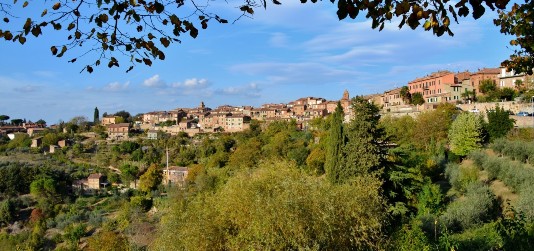Umbria
Geography and Climate
 |
Umbria is called the green heart of Italy and is often compared to Tuscany. You will find beautiful cities such as Assisi, Perugia and Orvieto. One third of the region consists of mountains and the rest of hills with landscapes that are among the most beautiful in Italy. The gently rolling hills are covered with extensive vineyards and olive groves with medieval towns in between. Lake Trasimeno, on the border with Tuscany, is the fourth largest lake in Italy with its 129 km². Lake Trasimeno is a real tourist attraction, you can practice all kinds of sports, windsurfing, kite surfing, cycling, walking, ...
 |
| the Marmore Waterfall |
In summer there is a hot, dry and sunny climate in Umbria, but winters can be quite cold and wet, especially at higher altitudes such as in the Apennines. The average temperatures are 32°/15°C (max/min) in summer and 11°/1°C in winter.
In the east of Umbria there is a risk of medium to strong earthquakes.
Food and drinks
 |
| a Bacio Perugina text message |
The region is known for its Perugina chocolate. You may know “Baci Perugina”, delicious hazelnut-filled chocolate kisses. In every Bacio you will find a note with a nice multilingual love message.
In Umbria meat has an important role in the local kitchen, especially grilled or roasted meat. Everywhere you will find Porchetta, boneless pork, seasoned with garlic, rosemary, sage, wild fennel, pepper and salt and then roasted. The deliciously tender and spicy meat really makes your mouth water. The town of Norcia is known throughout Italy for its pork and meats products. Anyone who has traveled to Umbria will undoubtedly know typical products such as Prosciutto di Norcia, Palle del Nonno, Coglioni di Mulo, and many types of Salame or salted sausage of wild boar, deer or with truffle, to name but a few.
Furthermore, most of the (dry) pasta is produced in Umbria and the fragrant, dark green olive oil is among the best in Italy. Umbria is known for its delicious black truffle dishes. Important white wines with Trebbiano, Grechetto and Malvasia grapes mainly come from the Orvieto region and the most famous local red wine is Rosso di Montefalco.
Economy and Health care
 |
| the Basilica of Saint Francis of Assisi |
The region of Umbria is halfway up the crime index list, with 3,457 reports of crime per 100,000 inhabitants, just below the national average of 3,816. In Italy, the average figure for the number of reported thefts and thefts in homes is 2,051 per 100,000 inhabitants (2020). In Umbria, it is 1,910, just below the Italian average, placing the region in 8th place nationally.
For the health care system the region was divided into two areas. In practice the territory was divided into north and south and therefore the division does not coincide with the two provinces of the region.
 In the north there are 7 hospitals and in the south 9, for a total of 900,000 inhabitants. These are the links to the pages of the Servizio Sanitario Regionale USL Umbria 1 and USL Umbria 2.
In the north there are 7 hospitals and in the south 9, for a total of 900,000 inhabitants. These are the links to the pages of the Servizio Sanitario Regionale USL Umbria 1 and USL Umbria 2.Second homes
Both the province of Perugia (17) and Terni (9) are in the top 20 regions in Italy with relatively the highest number of foreigners who have settled permanently in Italy, when they have reached retirement age. Relatively speaking, you will find many Dutch and even more Belgians in both provinces, but there is also a remarkable presence of English citizens, especially in the province of Perugia. The most popular towns with more than 1.8% inhabitants of Western European origin are Monte Santa Tiberina (PG), Montegabbione (TR), Monteleone di Orvieto (TR), Monte Castello di Vibio (PG), Montone (PG), Piegaro (PG), Ficulle (TR) and San Venanzo (TR).
The most beautiful towns
 |
| Deruta |
These are the villages of the province of Perugia that are mentioned in the guide: Bettona, Bevagna, Castiglione del Lago, Citerna, Corciano, Deruta, Massa Martana, Monte Castello di Vibio, Giano dell'Umbria, Montefalco, Monteleone di Spoleto, Montone, Nocera Umbra, Norcia, Paciano, Panicale, Passignano sul Trasimeno, Preci, Scheggino, Sellano, Spello, Torgiano, Trevi and Vallo di Nera.
And these are the villages of the province of Terni: Acquasparta, Allerona, Arrone, Lugnano in Teverina, Montecchio, Monteleone D'Orvieto, Stroncone and San Gemini.
The guide “Bandiere Arancioni” is the counterpart of Borghi più Belli, which is published by the Italian Touring Club. The same villages are often mentioned in both guides. In the case of Umbria, this last guide also mentions Città della Pieve (PG).


